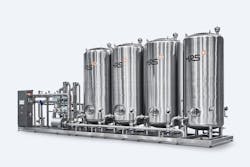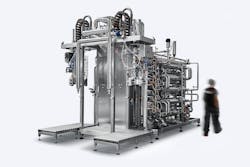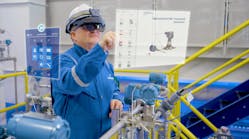Modern food production systems have reduced the cost of foods and made them more available, but general trends toward the centralization of food supply also increases the opportunity that food safety issues, such as contamination with pathogens or toxins will affect large numbers of people1. To prevent this, food producers implement strict systems such as Hazard Analysis and Critical Control Points (HACCP), but the design and manufacturing standards of food processing equipment are also of vital importance.
Types of contamination
The contamination of food and beverage products can cause anything from minor quality issues to severe health outcomes and even death. There are four main types of contamination which can affect food and drink products: microbial, chemical, physical and allergenic.
Microbial contamination is caused by microorganisms such as bacteria, viruses, mold, fungi and toxins like campylobacter, salmonella and E. coli. Microbial contamination is the most common source of food poisoning. Control measures include strict hygiene standards, ensuring separation between raw and cooked ingredients, and the use of techniques to reduce the microbial load in the product, such as pasteurization or sterilization.
Chemical contamination often arises from the poor control of products used for cleaning and disinfection. If chemical residues remain on food preparation or contact surfaces, or if chemicals are used in the vicinity of food and drink products, then contamination can occur. Another source of chemical contamination may be the production of primary food ingredients such as the incorrect use of pesticides and medicines on farms.
As the name suggests, physical contamination is caused by foreign objects, and can include anything from stones and pest bodies through to items of plastic or metal. Within food processing facilities, poorly maintained or badly designed equipment can itself become a source of physical contamination in the form of items such as flaking paint or loose screws. Physical contaminants may also carry harmful bacteria, increasing the overall contamination risk.
The final source of contamination is allergenic contamination, which occurs when a food which causes an allergic reaction encounters another food. There are 14 recognized allergens2, including gluten, peanuts, eggs, mustard, soy and fish, and the reactions caused can range from mild discomfort through to fatal anaphylactic shock.
The importance of design
Food processors adopt a range of processes and procedures to prevent these forms of contamination from occurring. These measures may include cleaning and maintenance procedures, pest control, personal hygiene, protective clothing, dress codes, etc. Many of these procedures will have been implemented because of a HACCP assessment of the facility and the production methods employed, but there is another equally important aspect of avoiding contamination which is not always given such a high profile: the design and construction of the food processing equipment itself.
Hygienic equipment design enhances cleanability, decreasing the risk of biological, physical and chemical contamination. In addition, equipment that is designed and constructed to meet hygienic principles is easier to maintain and reduces the risk of physical hazards3.
Hygienic design principles encompass a range of different factors, including material choice, surface finish and construction methods, as well as the physical design of the product — for example avoiding lips, crevices and sharp angles where cleaning chemicals or product may build up or remain after cleaning. To facilitate cleaning underneath and around equipment, it should be elevated above the floor on legs or mounted in a frame.
When designing equipment, different standards may be applied to food-contact and non-contact surfaces, and surfaces which encounter product must generally be smooth, non-toxic, non-absorbent and resistant to corrosion. For this reason, stainless steel is a popular choice and AISI 300-series stainless steel (as specified by 3A Sanitary Standards) is used as a key material. Welding and joints are also important; continuous butt welds should be used and ground to a smooth surface, while bolts and threads used within the food contact zone must be of a hygienic design.
It is also important to maintain the movement of fluids and materials within the equipment and connecting pipework. Maintaining flow and preventing fouling is also a key priority in heat exchanger design and is why HRS Heat Exchangers produce corrugated tube- or scraped-surface designs. It is also important to use closed coupled connections to equipment to prevent the creation of dead spots, and to ensure that, where necessary, equipment can be fully drained or emptied for cleaning or product changeover. Other considerations include avoiding the use of O-ring seals in grooves, avoiding ledges around top rims and ensuring that shafts are suitably sealed with double seals where necessary.
Reducing waste while maintaining safety
HRS Heat Exchangers produces a wide range of equipment for use in the food and beverage sectors, from basic tubular heat exchangers to fully integrated pasteurization/sterilization and aseptic filler systems, as well as several specialist products such as evaporators, ice crushers and melters, direct steam injection systems, air removal systems and pumps. All of these are hygienically designed from the start to facilitate clean operation and prevent the types of product contamination discussed above. All HRS products designed for food use meet 3A Sanitary Standards.
Furthermore, HRS equipment is particularly designed to facilitate product removal and subsequent cleaning. It has always been a challenge for food and drink businesses to implement effective and rigorous clean-in-place (CIP) regimes which meet the necessary standards in a way which minimizes the loss or degradation of saleable or useful product. One example is the HRS R Series of rotating scraped surface heat exchangers which can physically remove product without the need for traditional pigging or flushing systems.
The R Series is suitable for a range of heat transfer applications and its unique design enables high viscosity products to be pumped with reduced back pressure and lower energy use. The helical spiral is fitted with scrapers — which scrape the surface of the tubes to prevent fouling in normal use — can also be run in reverse; thereby enabling valuable product to be recovered prior to routine cleaning or product changeover. This design feature means that much of the product can be removed from the HRS R Series without the need for additional pumps or pressure systems, reducing both CAPEX and OPEX.
HRS also produces a Product Recovery System, which combines continual monitoring of a set parameter (for example Brix, pH or viscosity) with the three-way valve technology employed in every HRS pasteurizer or sterilizer. Working together, these two systems ensure that all product which meets the set parameters is used and only that which falls outside (for example, that diluted prior to or during CIP) is discarded. Furthermore, such monitoring helps to validate the effectiveness of CIP and ensures that following a cleaning cycle, only product that meets specification is allowed to proceed.
The hygienic design and construction of food processing equipment is an essential but often overlooked aspect of controlling the safety and quality of food and drink products, playing a crucial role in preventing contamination and allowing other food safety procedures to be carried out.
Matt Hale is International Sales & Marketing Manager for HRS Heat Exchangers.
REFERENCES:
- Food production and food safety: https://www.ncbi.nlm.nih.gov/pmc/articles/PMC1116029/
- https://www.highspeedtraining.co.uk/hub/four-types-contamination/
- Food Equipment Hygienic Design: An Important Element of a Food Safety Program: https://www.food-safety.com/articles/3705-food-equipment-hygienic-design-an-important-element-of-a-food-safety-program




